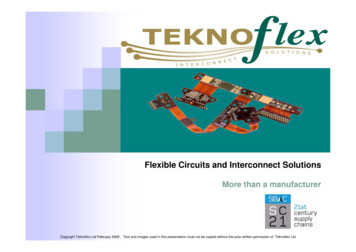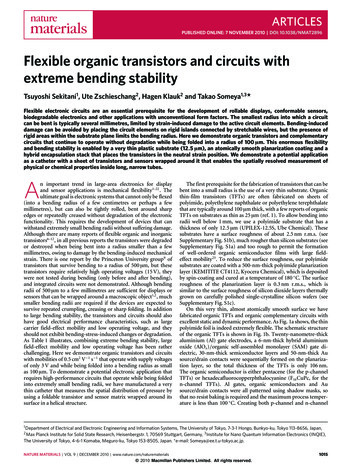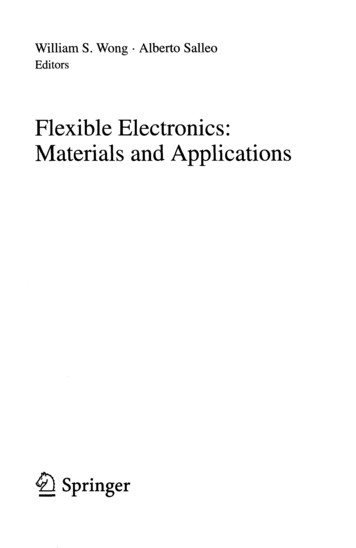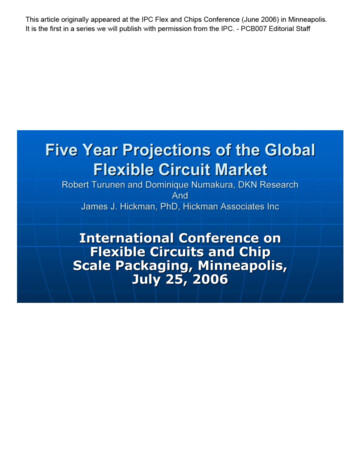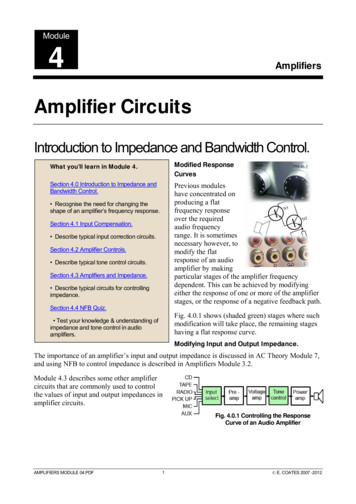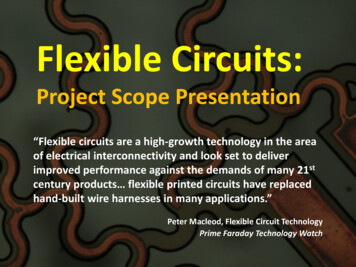
Transcription
Flexible Circuits:Project Scope Presentation“Flexible circuits are a high-growth technology in the areaof electrical interconnectivity and look set to deliverimproved performance against the demands of many 21stcentury products flexible printed circuits have replacedhand-built wire harnesses in many applications.”Peter Macleod, Flexible Circuit TechnologyPrime Faraday Technology Watch
What is diabetes?A metabolic disease in which the body’s inability toproduce any or enough insulin causes elevated levelsof glucose in the blood.If not controlled, diabetes can produce complications that canaffect nearly every organ in the body: heart attack stroke atherosclerosis high blood pressure neuropathy nephropathy cataracts and glaucoma foot damage and possible limbamputation hearing impairment skin conditions Alzheimer's disease
Diabetes CareMedical CareMedicationDietGlucose Monitoring
Glucose MonitoringFor some people, it is necessary to monitortheir blood glucose levels daily—andsometimes more than once a day!Fact: Glucose levels can be also measured inother corporal (human body) fluids Knowing this Could an alternative to theannoying pinching procedure be developed?
Example Idea: Smart Lens Developed by Google Labs and Novartis The lens can measure blood sugar levelsdirectly from tear fluid on the eyeball surface It contains a low-power microchip and an almostinvisible, hair-thin electronic flexible circuit The system sends data to a mobile deviceto keep the person informed.
Flexible ElectronicsAt the core of the Google smart lensis a thin and flexible printed circuit“A flexible printed circuit is a patternedarrangement of printed circuitry andcomponents that uses a flexible base materialwith or without a flexible cover lay.”—IPC, Association Connecting Electronics Industries
Flexible Circuit Compositionflexible circuit dielectric substrate film(base material) electrical conductors(circuit traces) protective finish(cover coat) adhesives(bond materials)
Flexible Circuit CompositionSubstrate materials: Polyesters: Low cost and highly flexible Polymides: high-temperature characteristics( 700 oC) and low thermal expansionElectrical conductors: Gold, aluminum, nickel or silver, but mainly copper Ink loaded with carbon or silver particles
Flexible Circuit CompositionSingle-Sided Flexible Circuits Most common type Single conductor layer on a flexible dielectric film Access to circuit-termination from one side only With or without cover lays and protective coatings Simple design; highly cost effective Best suited to dynamic-flexing
Flexible Circuits CompositionSingle-Sided Flexible CircuitsBase SubstrateAdhesiveConductorCoverlay
Flexible Circuit FabricationPhotolithography
What is the research?The UV light exposure step in the photolithographyprocess is the core of the research performed for thislesson. Note that the circuit mask is placed over thewafer coated with the photoresist. Challenge question:Is it expected that that theprinted circuit is an exactcopy of the mask, or is analteration produced by thepass of the UV lightthrough the photoresistcoat? Or, is the diffractionof the light in this coatingsignificant?
What is the research?To answer this question, we must compare thedimensions of a circuit in the original mask, and thedimensions of the final circuit obtained through thephotolithography process.
What is the research?We will take samples of measurements fromtwo sets of pictures: original circuits on masksand their corresponding printed circuits.We will use aspecial graphinterface createdin GeoGebra toperform thesemeasurements
What is the research?We will use statistical analysis, hypothesis testing fordifferences, to conclude if the differences in dimensionsmask-printed circuits are statistically significant or not.A T-test isthe correctapproach fordependent orindependentsamplesDependent or Paired Data
What is the research?We’ll put the measurements from the different circuitstogether in a relative size change graphWe’ll usethe equation:xm x pxm 100to compute thedependentvariable y of thegraph
What is the research?Taking logarithm of the y variable, a linear relationshipcan be found. Solving for y, an empirical relationship forthe relative change can be obtained.With thisequation, it ispossible topredict thechange in theprinted circuitas a functionof the originaldimensions
Suggested reading:- Photolithography: http://en.wikipedia.org/wiki/Photolithography- What is nition/photolithography- Carl Batt: Photolithography:http://www.youtube.com/watch?v 9x3Lh1ZfggM- Semiconductor Lithography. The Basic sics.html- What Else Could Smart Contact Lenses at-else-couldsmart-contact-lenses-do/- Google's Prototype "Smart Contact Lens": Measuring Blood GlucoseLevels for People with 418/12
CustomCustom ShowsShows
Flexible Circuit FabricationPhotolithography
Sputter DepositionA method of depositing thinfilms by way of erodingmaterial from a “target”source onto a “substrate.”Typically accomplished bybombarding the “target”(that is, the source ofdeposition material) withatoms of inert gas.The momentum of thebombarding atoms transfers totarget atoms enabling them toseparate from the target flyingtowards the deposition surface.
Flexible Circuit FabricationPhotolithography
Cleaning ImpuritiesOrganic / inorganic contaminations are usuallyremoved by wet chemical treatment using solutionscontaining hydrogen peroxide.Other solutions made with trichloro-ethylene, acetoneor methanol may also be used to clean
Flexible Circuit FabricationPhotolithography
Photoresist CoatingA UV light-sensitive liquid that loses its resistance (its susceptibilityto attack by an etchant or solvent) when exposed to UV light.A wafer coated with a thin conductor, is covered with photoresistby spin coating; this viscous liquid solution is dispensed onto arapidly spun wafer, to produce a uniformly thick layer.
Flexible Circuit FabricationPhotolithography
UV Light ExposureUV light passes through a mask (a print of the circuit tobe transferred to the wafer) placed on the conductorcoated wafer. Light causes a chemical change on thephotoresist. Positive photoresist becomes soluble in thedeveloper when exposed; with negative photoresist,unexposed regions are soluble in the developer.
Flexible Circuit FabricationPhotolithography
Photoresist RemovalAfter a photoresist isno longer needed, itmust be removedfrom the substrateThis usually requires aliquid resist stripperor developer thatchemically alters theresist so that it nolonger adheres to thesubstratePhotoresist Developer
Flexible Circuit FabricationPhotolithography
EtchingA liquid ("wet") or plasma ("dry") chemical agentis used to remove the uppermost layer of thesubstrate in the areas that are not protected byphotoresist
Flexible Circuit FabricationPhotolithography
StrippingThe use of a solvent called a stripper to removethe photoresist and any of its residues
Flexible Circuits: Project Scope Presentation "Flexible circuits are a high-growth technology in the area of electrical interconnectivity and look set to deliver improved performance against the demands of many 21st century products flexible printed circuits have replaced hand-built wire harnesses in many applications." Peter Macleod, Flexible Circuit Technology




